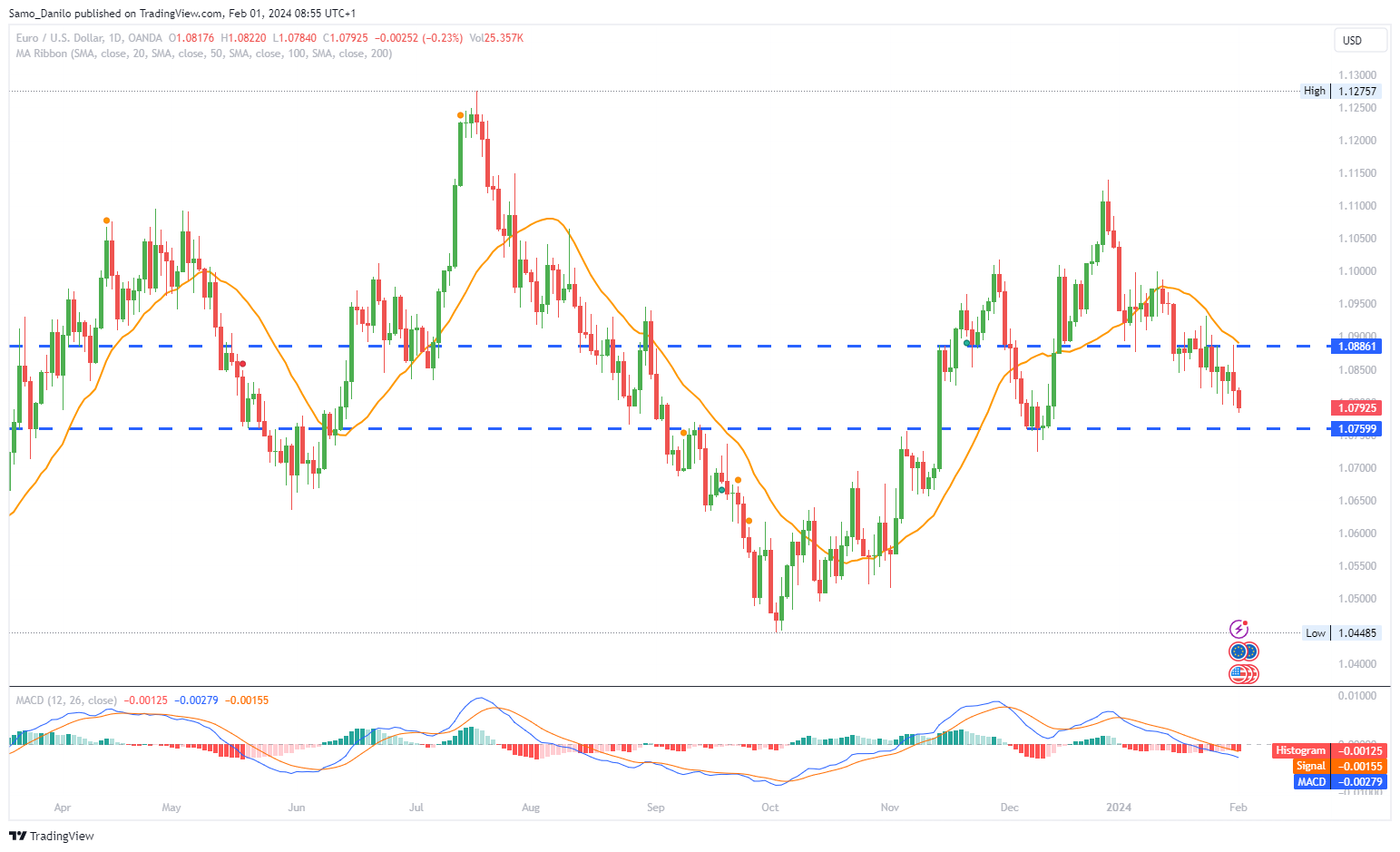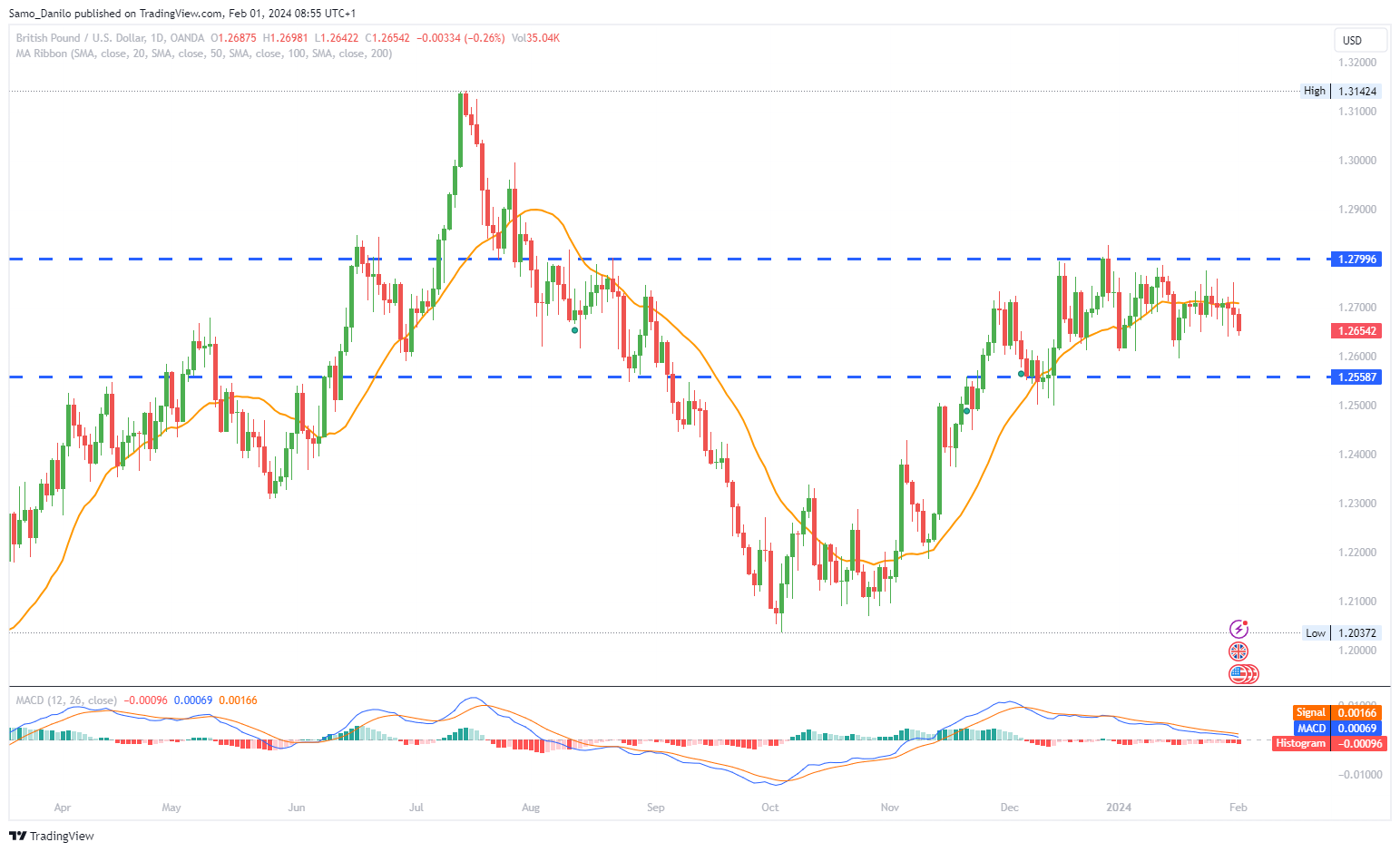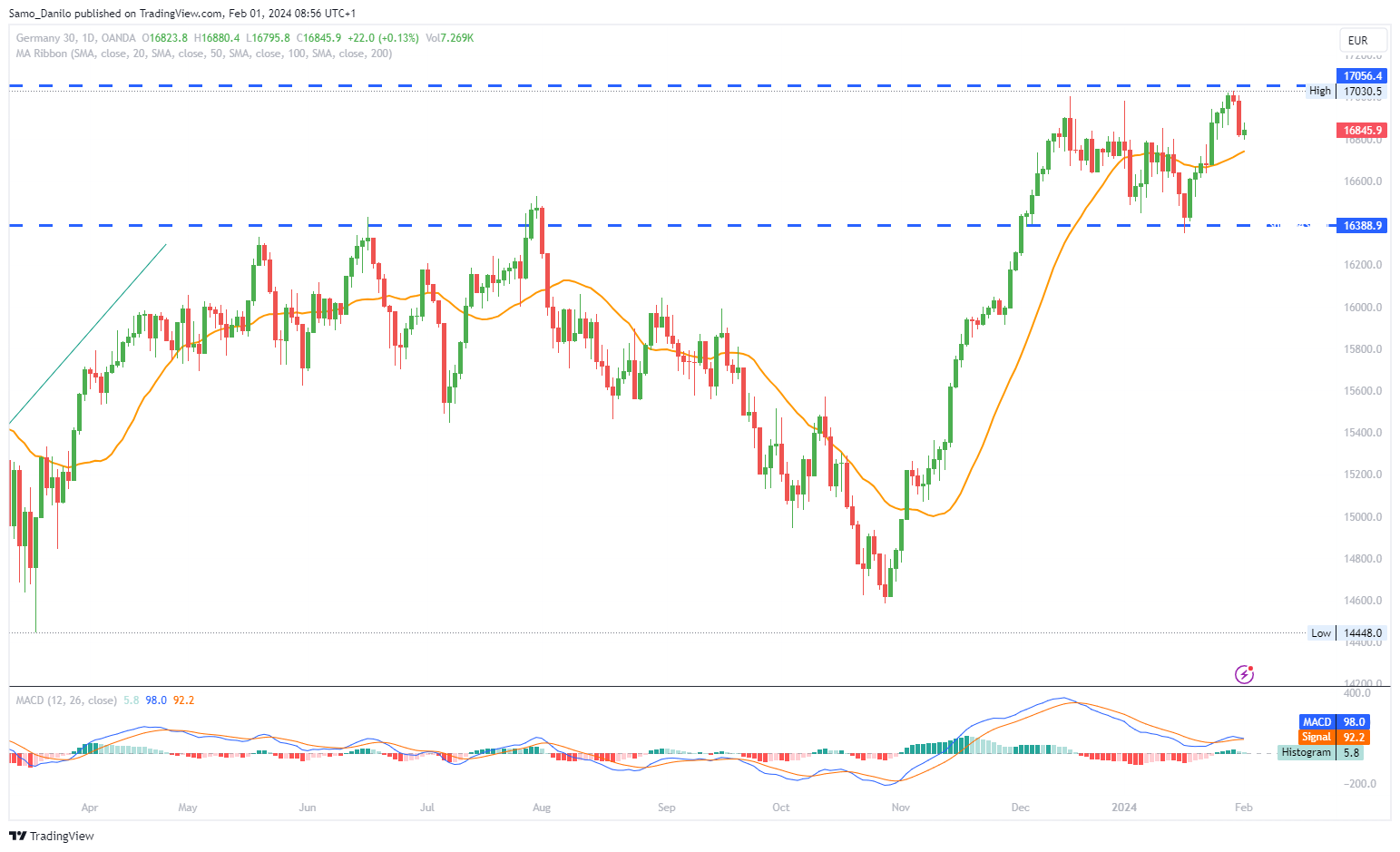EURUSD
- The EUR/USD pair experienced renewed selling momentum, driven by bullish strength in the US dollar. This pushed the pair towards the lower end of the weekly range, settling near the 1.0800 region. The direction of the currency pair is influenced by factors affecting both the euro and the US dollar.
- The Federal Reserve (Fed) played a significant role in recent market movements. The Fed's decision to unanimously keep its Fed Funds Target Range unchanged at 5.25%-5.50% was in line with expectations.
- Fed Chair Jerome Powell, in the subsequent press conference, provided insights into the Fed's stance, stating that decisions will be made meeting by meeting and expressing the belief that the policy rate is likely at its peak.
- The debate among investors continues regarding the timing of the first interest rate cut. The probability of a rate cut in March is around 36%, while the probability for a rate cut in May stands at approximately 58%, according to the FedWatch Tool by CME Group. This uncertainty contributes to the cautious approach among market participants.
- With the Federal Open Market Committee (FOMC) meeting concluded, attention shifts to the publication of the critical US Nonfarm Payrolls on February 2. The employment data is closely monitored as it provides insights into the labor market's health, and a stronger-than-expected or weaker-than-expected report could impact expectations regarding the timing of a potential move on interest rates in March or May.
Closing statement: The recent dynamics in EUR/USD are influenced by the Fed's decisions, Chair Powell's statements, and ongoing speculation about the timing of interest rate cuts. The focus now turns to the US Nonfarm Payrolls report for further clarity on the economic outlook.
GBPUSD
- GBP/USD is experiencing a decline, approaching the 1.2650 level during European trading on 'Super Thursday'. The term 'Super Thursday' refers to the Bank of England's (BoE) practice of releasing its interest rate decision, meeting minutes, and quarterly Inflation Report all on the same day.
- The Bank of England is holding its policy rate steady for the fourth consecutive meeting. This is the first policy meeting of 2024 and is expected to provide direction for the Pound Sterling (GBP) market in the coming months.
- Currently, the markets are pricing in approximately 100 basis points (bps) of rate cuts for this year, with expectations starting in the second quarter. The anticipation of rate cuts is a key factor influencing the performance of GBP/USD.
- Despite market expectations, the BoE is expected to maintain its current restrictive stance, affirming the narrative of "higher interest rates for longer." This suggests a resistance to the market's expectation of early rate cuts.
- In addition to the interest rate decision, investors are closely watching the central bank's updated inflation and growth forecasts. These forecasts, along with Governor Andrew Bailey's press conference, are expected to provide fresh insights into the timing of the BoE's potential policy pivot.
| SMA (20) | Neutral | |
| RSI (14) | Neutral |
|
| MACD (12, 26, 9) | Slightly Falling |
|
Closing statement: The movement in GBP/USD on 'Super Thursday' is influenced by the BoE's policy decision, market expectations for rate cuts, and the central bank's guidance on inflation and growth. Traders will closely analyse the outcomes and statements for indications of the future direction of GBP/USD.
GOLD
- Gold price is showing a positive momentum, aiming to retest the two-week high of $2,056 reached on Wednesday. The recent performance of gold is marked by fluctuations in response to various economic and geopolitical factors.
- China's Vice Finance Minister Wang Dongwei announced on Thursday that they will "appropriately increase investment under the central government budget." This move is expected to support the expansion of domestic demand. Such announcements can influence gold prices as they signal economic policy changes.
- China’s Caixin Manufacturing Purchasing Managers Index (PMI) remained at 50.8 in January, indicating steady growth in the country’s manufacturing sector. The actual reading surpassed the market consensus of 50.6. Economic indicators from China can impact gold prices, especially considering China's significant role in global trade.
- The U.S. Federal Reserve, led by Chair Jerome Powell, extended the pause in rate decisions. Powell mentioned, "based on the meeting today, I don't think likely we will have a rate cut in March." This commentary impacts the market's expectations for future rate cuts, influencing gold prices.
- Traders are now turning their attention to Friday’s US Nonfarm Payrolls data, which is considered a key economic indicator. The data will be closely watched to affirm the pushback to May for the Fed to lower interest rates. Ahead of this, other economic indicators such as US Jobless Claims, Unit Labor Cost (Q4), and the ISM Manufacturing PMI will be monitored for potential trading impetus in gold prices.
| SMA (20) | Slightly Falling |
|
| RSI (14) | Slightly Rising |
|
| MACD (12, 26, 9) | Neutral |
Closing statement: Gold prices are influenced by a combination of global economic policies, geopolitical events, and economic indicators. The current positive momentum is shaped by announcements from China, the Fed's decision, and anticipation of upcoming economic data.
CRUDE OIL
- Western Texas Intermediate (WTI), the US crude oil benchmark, is currently trading around $75.80. This comes after a rebound from the weekly lows of $75.43 recorded on Thursday. The recent price action reflects a recovery from lower levels.
- WTI prices have rebounded, snapping a three-month losing streak, driven by ongoing geopolitical tensions in the Middle East. These tensions are contributing to elevated risks in global crude supply, providing support to oil prices.
- The Executive Director of the International Energy Agency (IEA), Fatih Birol, stated that global oil demand is expected to increase by 2 mb/d in 2024. This projection is similar to the growth achieved in 2023. Outlooks on future demand play a crucial role in shaping oil prices.
- The upside potential for WTI prices might be limited due to disappointing Chinese Manufacturing PMI data. China’s NBS Manufacturing PMI for January came in at 49.2, slightly above the prior reading of 49.0 but below the market consensus of 49.2. Weak economic data from China can influence oil prices.
- Later today, the US weekly Initial Jobless Claims and ISM Manufacturing PMI are scheduled. These events have the potential to significantly impact the USD-denominated WTI price. Oil traders will closely monitor these data releases for trading opportunities and cues regarding the health of the US economy.
| SMA (20) | Slightly Rising |
| |
| RSI (14) | Slightly Falling |
| |
| MACD (12, 26, 9) | Rising |
|
|
Closing statement: In summary, the recent rebound in WTI prices is attributed to geopolitical tensions in the Middle East and the IEA's positive outlook on global oil demand. However, challenges posed by disappointing Chinese economic data and upcoming US economic indicators could shape the future direction of WTI prices.
DAX
- On Wednesday, German retail sales experienced an unexpected decline of 1.6% in December, following a 0.8% slide in November. These figures supported the narrative of a potential economic recession in Germany in the first quarter of 2024. Retail sales are often considered a key indicator of consumer confidence and economic health.
- Despite the downturn in retail sales, softer-than-expected German inflation numbers raised speculations about an April rate cut by the European Central Bank (ECB). The annual inflation rate eased from 3.7% to 2.9% in January. Inflation figures are crucial in shaping monetary policy decisions, and a lower-than-expected inflation rate can lead to expectations of rate cuts.
- The Federal Reserve (Fed) left interest rates unchanged at 5.50% overnight on Wednesday. However, Fed Chair Powell stated that the Fed would need confidence that inflation can sustainably move towards 2% before considering rate cuts. This commentary provides insights into the Fed's stance on monetary policy.
- Today, German manufacturing PMI and Eurozone inflation numbers are scheduled to be released, garnering investor interest.
- Beyond the economic indicators, ECB President Christine Lagarde and Chief Economist Philip Lane are on the calendar to speak. Reactions to the inflation numbers and the speeches by ECB officials could influence market sentiment.
| SMA (20) | Slightly Rising |
|
| RSI (14) | Slightly Falling |
|
| MACD (12, 26, 9) | Slightly Rising |
|
Closing statement: In summary, recent economic data from Germany, including retail sales and inflation figures, have shaped expectations regarding the country's economic outlook and potential ECB actions. The Fed's decision and upcoming data releases will likely influence investor sentiment in the DAX.




